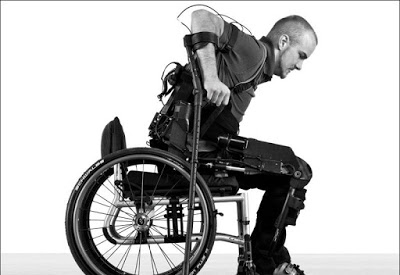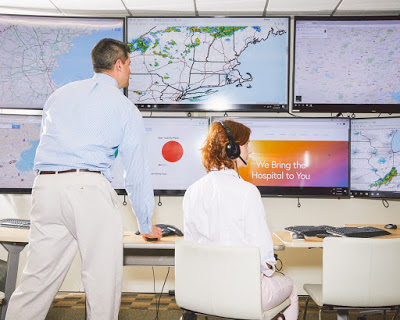Is it Finally Time to Reinvent the Wheel?
 Kim BellardWhen people talk about "reinventing the wheel, " it is often meant to discourage, even disparage. As in, "why reinvent the wheel?" It usually refers to a technology or a process that works well enough and is widely enough distributed that trying to replace it would be a fool's errand.
Kim BellardWhen people talk about "reinventing the wheel, " it is often meant to discourage, even disparage. As in, "why reinvent the wheel?" It usually refers to a technology or a process that works well enough and is widely enough distributed that trying to replace it would be a fool's errand.
Fortunately, the folks at DARPA aren't afraid of fool's errands -- and they are literally reinventing the wheel. Healthcare could use some fool's errands of its own. We all know what a wheel is. We know a wheel when we see one, we know what one does, we know how they do it. We've all traveled on wheels -- skates, bikes, cars, buses, whatever. It's hard to imagine a world before the wheel, before that beautiful circular shape, and it's hard to imagine improving on it.
DARPA can. The DARPA effort is part of its Ground X-Vehicle Technologies (GXV-T) initiative, aimed at coming up with "disruptive technologies for traveling quickly over varied terrain." It includes some impressive innovations in suspensions and "crew augmentation" as well as the wheel reinvention, which consists of two distinct changes:
- Reconfigurable Wheel-Track (RWT): Wheel are round, but they don't always have to be. RWT allows the wheel to change on the fly from the classic round shape to a triangular track, and then back again. This is valuable when moving from a hard surface like a road to a soft surface like mud or snow. It's like having an on-demand tank tread.
- In-hub motor: Wheels are on axles that are turned by other sources. But maybe they don't have tobe. DARPA has tested putting motors directly insidethe wheel, allowing for "heightened acceleration and maneuverability with optimal torque, traction, power, and speed over rough or smooth terrain." And it still fits within the standard military 20" rim.
Here's their video:
OK, so these aren't ready for prime-time, especially in civilian settings. Maybe they never will be. But that's hardly the point. The point is, even with something as basic, as time-tested, and as prevalent as the wheel, there is more than can be done, and, sometimes, that should be done.
Not "why reinvent the wheel," but, rather, "why not reinvent the wheel?"
Here's a perfect example, and it's in healthcare. It's not much of a leap from thinking about wheels to thinking about wheelchairs. We have all kinds of wheelchairs, from your basic hospital model to motorized ones to ones used in racing marathons. Stephen Hawking controlled his using minute movement of his cheek muscle, for heaven's sake. You'd have to say there has been plenty of innovations.
So why can't wheelchairs climb stairs?
It turns out, they can. Or, rather, they could. As Allison Marsh recounted in IEEE Spectrum, an inventor named Ernesto Blanco invented one -- in 1962. He built a prototype for a design competition (which he didn't even win), but never did a full-sized model and never commercialized the idea.
In 1995 researchers at Nagasaki University did finally build an actual, full-sized wheelchair that could also climb stairs, but only built one model, which was donated to the local city council but retired in a few years due to lack of use. DEKA Research and Development Corporation had slightly more success with their iBOT, but never sold more than a few hundred units per year before it, too, was discontinued; price -- upwards of $29,000 -- was a factor.
Why would we even need a wheelchair that can climb stairs? After all, we have elevators, ramps, even in-home lifts. That's the why-reinvent-the-wheel mentality. That's not thinking of the people who need them. Maybe they just want to be able to get up the stairs on their own. Or maybe they'd rather be out of the wheelchair in something like a robotic exoskeleton.
 Robotic ExoskeletonThat's reinventing the wheel(chair). It's not about wheels, it is about re-imagining the given. Here's an example: in our current healthcare system, when you're sick, you to to the doctor's office. When you're really sick, you go to the hospital. Forget the fact that these are the times you least want to have to go anywhere. Forget the fact that those places are filled with lots of other people with whom you might exchange germs.
Robotic ExoskeletonThat's reinventing the wheel(chair). It's not about wheels, it is about re-imagining the given. Here's an example: in our current healthcare system, when you're sick, you to to the doctor's office. When you're really sick, you go to the hospital. Forget the fact that these are the times you least want to have to go anywhere. Forget the fact that those places are filled with lots of other people with whom you might exchange germs.
We do it because it is easier for the doctors and other health care professionals...but, again, that's not really supposed to be the point, is it?
We should be using telehealth more (and here's Chrissy Farr's take on why we're not), but, in the meantime, Healthcare Dive profiled "the return of the house call." Services like Heal or DispatchHealth believe that both the economics and the improved patient outcomes warrant the return, albeit with a 21st twist.
Nick Desai, CEO of Heal, told them: "We see (our house calls) as old-fashioned care with state-of-the-art technology." John Hopkins' Hospital at Home program takes it even a step further, trying to shorten or avoid hospital stays.
Similarly, Emma Yasinski profiled a company named Medically Home, which seeks to bring the hospital into patients' homes through a combination of technology and in-home visits and services. Their CEO told her:
Think of a rocket going into space. You have to be wired to all of the things going on in the rocket, to the astronaut. Everything happening in the home we have to be able to see, monitor, communicate to and from.
 "Mission Control" at Medically Home. Source-NeoLifeThat's not what generally we have now -- even when you are in the hospital. But it is possible now.
"Mission Control" at Medically Home. Source-NeoLifeThat's not what generally we have now -- even when you are in the hospital. But it is possible now.
Ira Wilson, a professor of health services at Brown, further told her:
The fixed costs of hospitals are just utterly gargantuan. One of the things we’ve got to figure out how to do in health care is to give people care in settings that provide all the resources that are necessary to treat the problem that they have — but not more,
Sounds like reinventing the wheel, doesn't it?
Pick your favorite windmill to tilt at. Pick the thing about healthcare you hate most of all. Don't assume that just because we do something a lot or use something a lot, it is the only way, much less the right way, to do it. Dare to come up with wheels that transform shape or power themselves.
Reinvent the wheel.
| Is it Finally Time to Reinvent the Wheel? was authored by Kim Bellard and first published in his blog, From a Different Perspective.... It is reprinted by Open Health News with permission from the author. The original post can be found here. |
- Tags:
- Allison Marsh
- DEKA Research and Development Corporation
- DispatchHealth
- Emma Yasinski
- Ernesto Blanco
- Ground X-Vehicle Technologies (GXV-T)
- Heal
- healthcare system
- iBOT
- In-hub motor
- Ira Wilson
- Kim Bellard DARPA
- Medically Home
- Nagasaki University
- Nick Desai
- Reconfigurable Wheel-Track (RWT)
- robotic exoskeleton
- wheelchairs
- Login to post comments